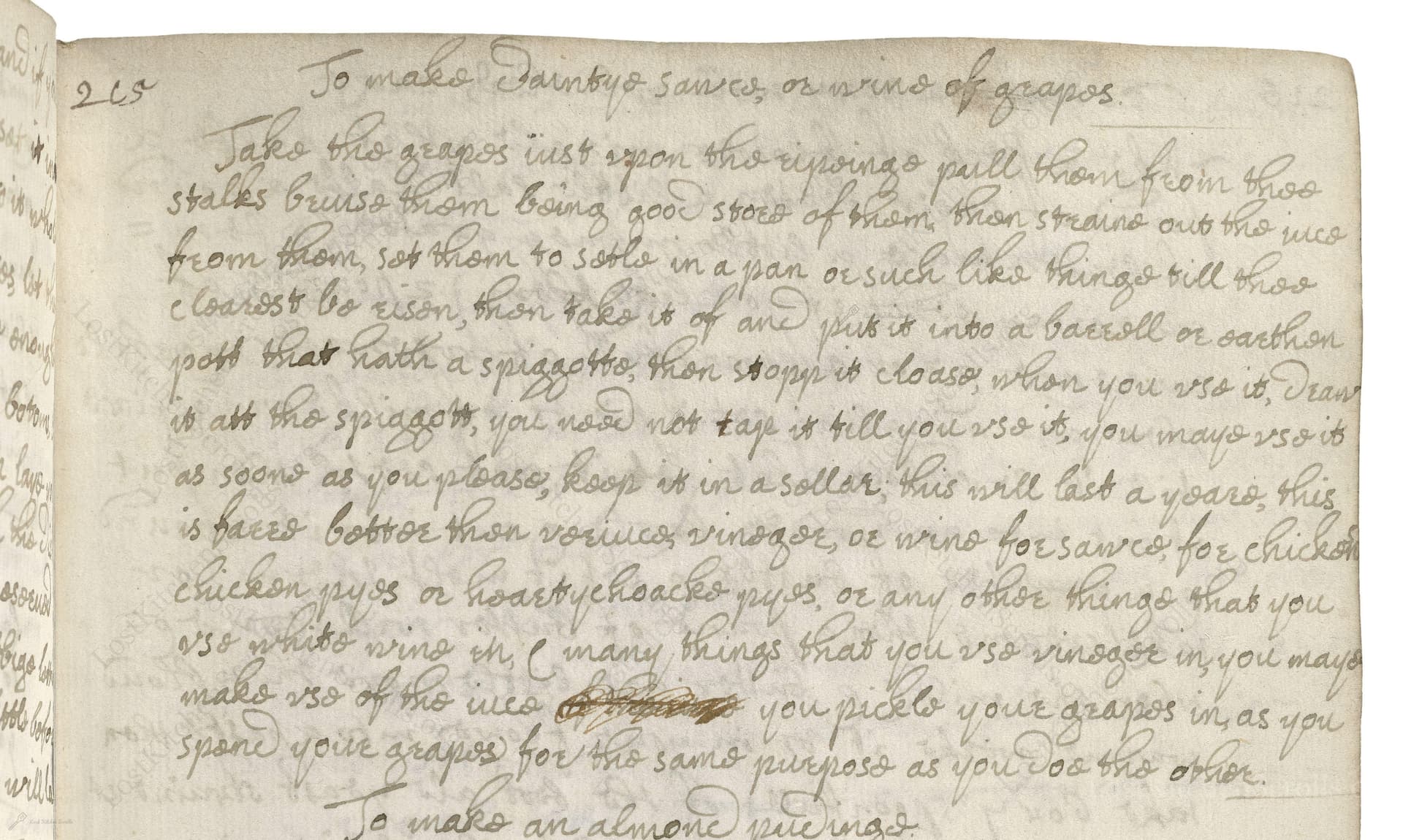To Make Daintye Sauce, Or Wine Of Grapes
From the treasured pages of Cookbook 1600s
Unknown Author

To Make Daintye Sauce, Or Wine Of Grapes
"Take the grapes just upon the ripinge pull them from the stalks bruise them being good store of them then straine out the iuce from them, set them to setle in a pan or such like thinge till the clearest be risen, then take it of and put it into a barrell or earthen pott that hath a spiggotte, then stopp it close, when you use it, draw it att the spiggott, you need not tap it till you use it, you maye use it as soone as you please, keep it in a sellar, this will last a yeare, this is farre better then veriuce, vinager, or wine for sawce for chicken chicken pyes or roastyechoacke pyes, or any other things that you use white wine in, & many things that you use vinager in, you maye make use of this iuce when you pickle your grapes in, as you spend your grapes for the same purpose as you doe the other."
Note on the Original Text
Early modern recipes were typically communicated orally or jotted as casual household notes; instructions are sparse, ingredients lack quantities, and assumed expertise abounds. Spelling and punctuation are irregular ('iucce' for juice, 'sellar' for cellar), and ingredients are listed by practical convenience, not strict measurement. The natural terminology—'when you use it, draw it att the spiggott'—reflects a world where kitchens blended pragmatic skill and improvisation, trusting the cook to judge readiness and use.

Title
Cookbook 1600s (1650)
You can also click the book image above to peruse the original tome
Writer
Unknown
Era
1650
Publisher
Unknown
Background
A delightful relic from the 1600s, this historical culinary manuscript tempts the senses with a medley of early modern recipes—seasoned with centuries-old knowledge and a dash of English tradition.
Kindly made available by
Folger Shakespeare Library
Created in the 1600s in England, this recipe derives from domestic manuscript sources and reflects a period when housewives prepared their own condiments and sauces from garden produce. 'Daintye sauce' or 'wine of grapes' was not only a primitive grape juice but also a versatile kitchen staple, considered purer and subtler than verjuice (the tart juice pressed from unripe grapes), vinegar, or even commercially imported wines. This grape 'wine' was especially valued for its gentle acidity and sweetness, enhancing both sweet and savory pies, roast dishes, and pickles at a time when culinary balances of sour and sweet defined fashionable tastes.

The original method required baskets or large bowls for harvesting grapes, sturdy hands or a pestle for crushing, linen or muslin cloths for straining, and earthenware pots or small barrels equipped with wooden spigots for storage. The cool of a cellar provided gentle preservation, exploiting natural fermentation-defying acidity in the grape juice. Today, a large bowl, potato masher, fine mesh strainer or cheesecloth, and a glass dispenser with a tap (or a sealable glass jar) are suitable modern equivalents.
Prep Time
20 mins
Cook Time
0 mins
Servings
10
We've done our best to adapt this historical recipe for modern kitchens, but some details may still need refinement. We warmly welcome feedback from fellow cooks and culinary historians — your insights support the entire community!
Ingredients
- 4 1/2 lbs fresh, just-ripe grapes (any seedless variety, white or red, but ideally the type traditionally grown in your region)
- Alternative: If table grapes are unavailable, use tart green grapes or even a blend of red and green for balance
Instructions
- To make Dainty Sauce, select freshly ripened grapes—about 4 1/2 pounds for a good yield.
- Remove them from their stalks and lightly crush the fruit to release the juice.
- Pour the crushed grapes into a large bowl or basin and strain thoroughly, squeezing as much juice as possible through a fine mesh strainer or cheescloth.
- Allow the strained juice to stand undisturbed in a clean bowl or container for several hours, ideally overnight in the refridgerator, so that any sediment can settle.
- Once the juice has clarified, carefully pour or siphon off the clear liquid, leaving any cloudy residue behind.
- Transfer the clear juice into a thoroughly cleaned glass or ceramic container with a tight-fitting lid or a spigot if possible (a modern beverage dispenser works well).
- Seal tightly and store in a cool, dark cellar or refrigerator.
- Use as needed for sauces, pie fillings, chicken dishes, or wherever white wine or vinegar is called for.
- This grape juice sauce will keep for up to one year when properly stored.
Estimated Calories
60 per serving
Cooking Estimates
It takes about 10 minutes to remove grapes from their stalks and crush them, plus about 10 minutes to strain the juice. The juice needs to rest in the fridge overnight to let the sediment settle. There is no actual cooking involved. The finished sauce is low in calories and makes about 10 servings.
As noted above, we have made our best effort to translate and adapt this historical recipe for modern kitchens, taking into account ingredients nowadays, cooking techniques, measurements, and so on. However, historical recipes often contain assumptions that require interpretation.
We'd love for anyone to help improve these adaptations. Community contributions are highly welcome. If you have suggestions, corrections, or cooking tips based on your experience with this recipe, please share them below.
Join the Discussion
Rate This Recipe
Dietary Preference
Main Ingredients
Culinary Technique

Den Bockfisch In Einer Fleisch Suppen Zu Kochen
This recipe hails from a German manuscript cookbook compiled in 1696, a time whe...

Die Grieß Nudlen Zumachen
This recipe comes from a rather mysterious manuscript cookbook, penned anonymous...

Ein Boudain
This recipe comes from an anonymous German-language manuscript cookbook from 169...

Ein Gesaltzen Citroni
This recipe, dating from 1696, comes from an extensive anonymous German cookbook...
Browse our complete collection of time-honored recipes



